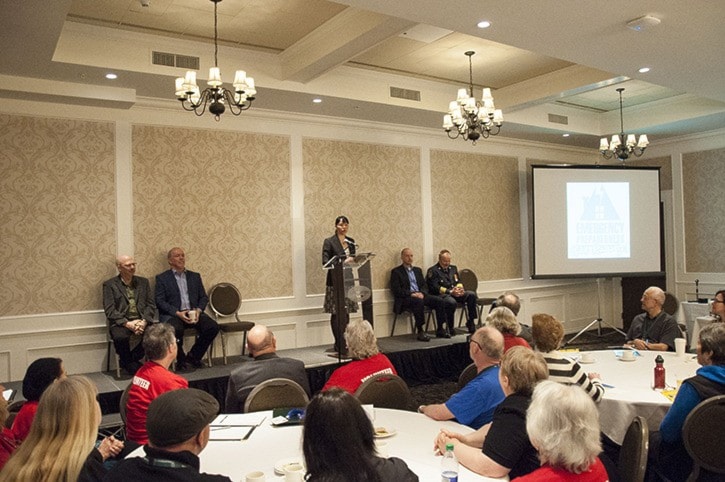“It’s not a matter of if, but of when,” is a phrase that was often heard at the Prestige hotel this weekend, which held the 2015 Vancouver Island Emergency Preparedness Conference.
There was some light-hearted humour from key speakers, a few slideshows, even some free parking — but in truth, the subject matter yelled out a rather stern message: we need to be more prepared in case of serious emergencies, like say, the Big One; a super-mega-bad-earthquake that could potentially return the entire West Coast - Sooke included - back to the Stone Age in one swift swing.
Sooke’s elite kicked off the opening ceremony early Saturday morning, with speeches from Fire Chief Steven Sorensen, Mayor Maja Tait, T’Sou-ke Nation Chief Gordon Planes, followed by several special guests including Juan de Fuca MLA John Horgan, MP Randall Garrison, Assistant Deputy Minister for Emergency Management B.C. Pat Quealey.
And there’s only one reason why visitors from all over B.C. - and indeed North America - packed the parking lots and convention halls: to know what we, the public, should do in case Mother Nature decides to blow her stack one day. This included several sessions on what you need to pack for an emergency kit, how to build one, and what you need to do keep yourself and your family prepared.
This avant-grande approach certainly didn’t exclude the first-responders and emergency specialists themselves.
Among the speakers was Brian Hutchinson, Captain for Vancouver Fire and Rescue, who pointed out that response agencies should be just as mindful of an event that could easily overwhelm their abilities.
“We have response agencies that say, you know what, we don’t actually have to plan for a disaster, ‘we respond to emergencies every day, and when it’s the big one, we’ll just respond like we normally do’ - but I think everyone in this room knows that that’s not gonna work for very long,” Hutchinson said.
He added that the initial emergency-response plan to earthquakes and other destructive events in B.C. was in fact from 1991 — and hasn’t been updated until now.
So, as a way to change that, Hutchinson said it was about engaging the emergency-response community and putting the plan into a new gear.
“We reached out to our partners in the city, our fire prevention, our school boards, BC Hydro, and our hospitals, our care facilities and we mapped them out,” he said. “We sat down, then drew out all the damage assessment routes.”
Hutchinson said his department reached out to the different fire halls to actually go out there and “pilot” these new routes - to “go out and drive it.”
And it’s not even about practice makes perfect, it’s about practicing these kinds of ideas in the first place that reduces the amount of confusion to first-responders, he noted.
Sending your crews out, expecting them to know their respective response areas and just know where to go, doesn’t work - they get drawn in where they think they should go in one shift, may not go in another place,” Hutchinson said. He added that creating a “pre-packaged plan” is what will make all the difference when something does happen.
“In Vancouver the first thing that will happen is a pre-packaged emergency plan will be implemented via our fire dispatch - it will go over radio, text - we did this with our pre-canned version and where our dispatchers had to verbalize it themselves,” he said.
And it’s more than just paperwork - planning on top of existing plans kind of thing - it’s about each of us getting involved and educating ourselves on emergency preparedness — because as Gordon Kouwenberg, Fire Chaplain for the Sooke Fire Department notes, when the ground starts looking like an Etch-a-Sketch, there’s only one thing that will likely happen: you’ll panic.
“Now you say, I’m going to grab my kids, going to go in my home, going to do this, or that - but when it happens, all that goes out the window,” he said, adding the only way to counter the panic is by practicing your emergency-response plan on a regular basis - that way, it pretty much becomes muscle memory.
“See the importance of this and get involved - don’t expect your dad or your mom to do it - sign up, volunteer, prepare - you’re giving to the community, sure, but you’re preparing your family as well. Because now you know what to do when it happens.”
